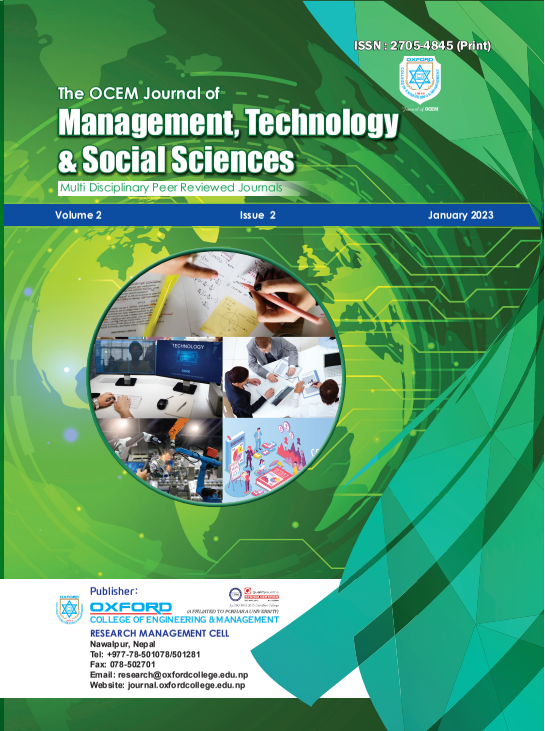A Review of an Article Based on the Mixed Methods Approach in Educational Sciences Regarding Teacher Retention Intention in the Asian Context
Abstract
The primary objective of this study was to evaluate the different models of the mixed methods approach along with research problems, questions, and data analysis techniques and to review its overall methodology applied to collect data in a selected educational article. A mixed methods approach is a newly emerged research design of this 21st century where both quantitative and qualitative data can be collected one at a time. This study was based on the review of different articles, books, cases, magazines, and newspapers connecting with the mixed methods approach. The key focus of this study was to introduce the mixed methods approach, quantitative and qualitative approaches, evaluate the theoretical strengths and weaknesses of the mixed methods approach, and explicit meaning of both qualitative and quantitative design and its applications in the different fields of research studies.
The results indicate that the study has covered different aspects of the mixed methods approach along with the theoretical weaknesses of the mixed methods approach. The results have also focused on both quantitative and qualitative research approaches along with the mixed methods approach and different designs of the mixed methods approach. The results further indicate that the core designs of the mixed methods approach are contemporary development and expansion designs, the validity and reliability of the mixed methods approach, the generalization of research outcomes, and statistical generalization. It was indicated that the key findings and discussions were also focused on while reviewing different journals and online documents. The results suggest that factors affecting teacher retention and attrition intention were based on the high workload and unsupportive colleagues and administration, which are similar within China, Nepal, India, and Sri Lanka. The results show that approximately 42% of the teachers reported being highly stressed in China; the same scenario has also occurred in the Nepalese context. The implications of this study would be beneficial to young researchers, students, college teachers and master-level students to foreground the knowledge in the mixed methods approach.
Keywords:
Convergent parallel design, mixed methods approach, qualitative approach, quantitative approach, teacher's retention, teacher attrition intentionDownloads
References
Adhikari, B. P. (2022). An investigation of the impact of the key components of the induction programme on new teacher retention in Chitwan district, Nepal. ResearchGate; ResearchGate. Retrieved from https://www.researchgate.net/ publication, accessed on 23rd November 2022.
Blenker, P. and Christensen, P.R, (2010) Hunting the entrepreneurial expertise:
entrepreneurs in education", in Fayolle, A. (Ed.), Handbook of Research in Entrepreneurship Education: International Perspectives, Edward Elgar,
Brunetti, G (2001). Why do they teach? A study of job satisfaction among long-term high school teachers, Teacher Education Quarterly; 28(2): 9–74
Caracelli, V. J. and Greene, J. C, (1993). Data analysis strategies for mixed-method evaluation designs. Educational Evaluation and Policy Analysis, 15:2, 195– 207.
Caruth, GD (2013). Demystifying Mixed Methods Approach Design: A review of
Literature: Mevlana International Journal of Education; 3:2, 112-122
Castro, F. G., Kellison, J. G., Boyd, S. J., and Kopak, A (2010). A methodology for conducting integrative Mixed Methods Approach and data analysis: Journal of Mixed Methods Approach, 4:4, 342-360
Chen, H., and Yang, S. (2009). The level of teacher job satisfaction and motivation policies: School Administration and Development: 12, 20–24
Collins, K.M.T, Onwuegbuzie, A.J. and Sutton, I.L, (2006). A model incorporating the rationale and purpose for conducting mixed-methods research in special education and beyond, Learning Disabilities: A Contemporary Journal; 4:1, 67-100.
Connelly, LN, (2009). Mixed Methods Studies; Medsurg Nursing: 18:1, 31-32
Creswell, J, Plano-Clark V. 2007. Designing and Conducting Mixed Methods Approach: Thousand Oaks: Sage
Creswell, J. W, (2007). Qualitative inquiry and research design: Choosing among five approaches (2nd ed.). Thousand Oaks: Sage Publications.
Creswell, J. W., and Plano Clark, V. L, (2011). Designing and conducting Mixed Methods Approach (2nd ed.). Thousand Oaks, California: Sage Publications Inc.
Creswell, J. W., Shope, R., Plano Clark, V. L., and Green, D, (2006). How qualitative interpretive research extends Mixed Methods Approach; Research in the Schools, 13:1; 1–11
Creswell, J.W, (2003). Research Design Qualitative, Quantitative, and Mixed Methods Approaches; New Delhi, Sage Publication
Creswell, J.W., and Tashakkori, A, (2007). Developing publishable mixed methods manuscripts. Journal of Mixed Methods Approach. 1:2, 107-111.
Creswell, JW. Klassen, AC., Plano Clark, VL. Smith, K.C, (2011). Best Practices for Mixed Methods Approach in the Health Sciences; Online resource retrieved from https://tigger.uic.edu/jaddams/college/business_office: accessed at 15th A Creswell, J. W. and Miller, D. L. (2000). Determining validity in qualitative inquiry: Theory into Practice, 39:3, 124–130
Curtis E, Redmond R, (2007). Focus groups in nursing research; Nurse Res; 14:25-37.
Darling-Hammond, L. (2003). Keeping good teachers: Educational Leadership, 60:8, 7–13
Dellinger, A.B. and Leech, N.L, (2007). Toward a unified validation framework in Mixed Methods Approach; Journal of Mixed Methods Approach; 1:4,309-32.
Denzin, N. K., and Lincoln, Y. S. (Eds.). (2005). Handbook of qualitative research (3rd ed.). Integrating Quantitative and Qualitative approaches in the Social and Behavioural Sciences; Thousand Oaks; Sage Publication
Durksen, T and Klassen, RM, (2014). Weekly self-efficacy and work stress during the teaching practicum: A mixed methods study: Learning and Instruction; 33:158-169
Eeva-Mari Ihantola Lili-Anne Kihn, 2011. Threats to validity and reliability in mixed methods accounting research; Qualitative Research in Accounting and Management; 8(1), 39 - 58
Flick, U, (2005). An introduction to qualitative research; London: Sage Publications.
Flower, FJ, (2013). The Survey Research Methods; USA, Sage Publication
Glik, D.C., Parker, K., Muligande, G., Hategikamana, B., (2005). Integrating qualitative and qualitative survey techniques. 1986–87: International Quarterly of Community Health Education: 25 (1–2); 115–133
Greene, J. C., Caracelli, V. J. and Graham, W. F, (1989). Toward a conceptual framework for mixed-method evaluation designs. Educational Evaluation and Policy Analysis, 11(3), 255–274.
Griensven, H.V., Ann P. Moore, AP., Valerie Hall, V, (2014). Mixed Methods ApproachThe best of both worlds? Manual Therapy 19(4); 367-371
Hall, V., Moore, AP., Griensven, H.v, (2014). Mixed Methods Approach-The best of both worlds? Manual Therapy: 19: 367-371
Hesse-Biber , S.N, (2010). Mixed Methods Approach: Merging Theory with Practice: New York, Guilford Press
Ingersoll, R. M., and Smith, T. M, (2003). The wrong solution to the teacher shortage; Educational Leadership; 60:8, 30–33
Ingham-Broomfield, RB (2015). A nurses' guide to Quantitative Research; Scholarly Paper: 32:2, 32-398
Jamieson L, Williams LM, (2003). Focus group methodology: explanatory notes for the novice nurse researcher; Contemp Nurse; 14:271-80
Jick, T. D. (1979). Mixing qualitative and quantitative methods: Triangulation in action. Administrative Science Quarterly, 24:4; 602–611.
Jogulu, UD. Pansori, J., Botswana, G (2011). "Mixed methods; a research design for management doctoral dissertation" Management Research Review; 34(6); 687701
Johnson, R. B., Onwuegbuzie, A. J., and Turner, L. A, (2007). Toward a definition of Mixed Methods Approach. Journal of Mixed Methods Approach, 1(2), 112–133
Lillis, A (2006). Reliability and validity in field study research", in Hoque, Z. (Ed.), Methodological Issues in Accounting Research: Theories and Methods, Paramus, London,
Liu, S and Onwuegbuzie, AJ, (2012). Chinese teachers' work stress and their turnover intention: International Journal of Educational Research: 53(7): 160–170
Liu, S., and Teddlise, C (2010). Differences in perceptions of effective schools' processes in differentially effective schools in China: International Journal of
Management in Education, 4, 348–368
Macdonald, D (1999). Teacher attrition: a review of literature: Teaching and Teacher Education: 15(9), 835-848
Mathison, S (1988). Why triangulate? Educational researcher, 17(2), 13–17
Mertens, D. M, (2005). Research and evaluation in education and psychology: Integrating diversity with quantitative, qualitative, and mixed methods (2nd ed.). Thousand Oaks, CA: Sage Publications
Onwuegbuzie, A.J. and Johnson, R.B. (2006). The validity issue in mixed research", Research in the Schools: 13 (1), 48-63.
Östlund, U., Kidd, L., Wengström, Y., & Rowa–Dewar, N. (2011). Combining qualitative and quantitative research within mixed method research designs: A methodological review. International Journal of Nursing Studies, 48(3), 369–383
Ostlund, U., Kidd, L., Wengstron, Y. and Rowa-Dewar, N. (2011). Combining qualitative and quantitative research within mixed method research designs: A methodological review; International Journal of Nursing Studies: 48(5), 369383
Pilot, DF and Beck, C.T, (2010). Generalization in quantitative and qualitative research:
Myths and strategies; International Journal of Nursing Studies; 47(11), 1451– 1458
Schifferdecker, K. E., and Reed, V. A, (2009). Using Mixed Methods Approach in medical education: Basic guidelines for researchers. Medical Education: 43(5), 637-644.
Skaalvik, EM and Skaalvik, S, (2011). Teacher job satisfaction and motivation to leave the teaching profession: Relations with school context, feeling of belonging, and emotional exhaustion: Teaching and Teacher Education; 27: 1029-1038
Stutchbury, K and Fox, A, (2009). Ethics in educational research: introducing a methodological tool for effective, ethical analysis; Cambridge Journal of
Education; 39(7).489-504
Subedi, B.S, (2008). School leadership as a major domain of school effectiveness; Teacher Education; 6(4), 102-120; Retrieved from http://www.nced.gov.np; accessed on 25th April 2015
Thorne, S., ( 2009). The role of qualitative research within an evidence-based context:
can meta-synthesis be the answer; International Journal of Nursing Studies:
46(9), 569–575.
Veldman, I., Tartwijk, JV, Brekelmans. Wubbels, T (2013). Job satisfaction and teacherstudent relationships across the teaching career: Four case studies: Teaching and Teacher Education; 32 (12); 55-65
Vinten, G (2015). Open versus closed questions – an open issue", Management
Decision; 33: 4: 27 - 31
Watanabe, R and Keeves, J (2003). International handbook of educational research in the Asia-Pacific, Paris, France, Springer Publication
Yilmaz, K (2013). Comparison of Quantitative and Qualitative Research Traditions:
epistemological, theoretical, and methodological differences: European Journal of Education: 48(2), 311–325
Yin, R.K (2006). Mixed Methods Approach: Are the methods genuinely integrated or merely parallel? Research in the Schools, Í3(1), 41-47
Downloads
Published
How to Cite
Issue
Section
License

This work is licensed under a Creative Commons Attribution 4.0 International License.
© 2024 by The OCEM Journal of Management, Technology and Social Sciences is licensed under CC BY-NC 4.0






